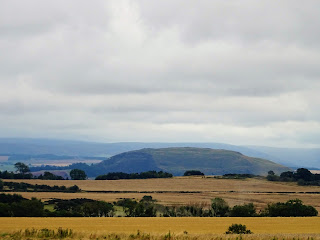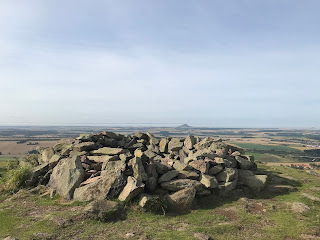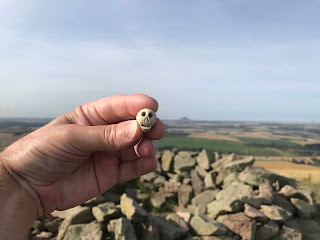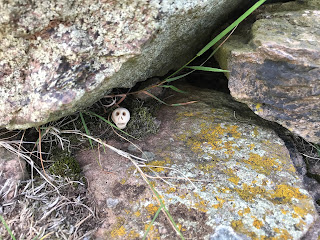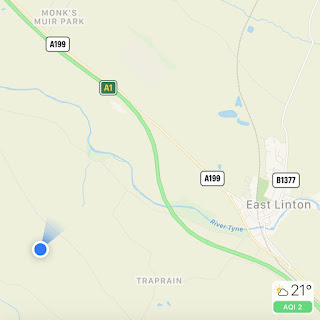Traprain Law is a hill that sits to the east of Haddington in East Lothian and at first glance it may seem like nothing more than just another hill. However, Traprain Law is anything but just another hill. It is a hill steeped in history and myth.
Traprain
Law was originally known as Dumpelder, or Dumpender Law and archaeologists have
found evidence of human habitation there dating from around 1000 BC. When the Romans occupied this area in the 1st
Century, they recorded the people living there as being the Votadini, a tribe whose
territory extended from South-East Scotland to North-East England. It is believed that at this time Traprain Law
was one of their major settlements.
In
1919 archaeologists excavating sites on Traprain Law discovered a hoard of
Roman silverware which became known as the Traprain Law Treasure. The hoard appeared to date from around the 4th
or 5th Century AD. Much of
the silver was cut up and it appears that it was being used as payment and
would probably be melted down by the local people and turned into goods such as
bracelets, brooches, and chains. In
total over 20 KG of silver was recovered, and this was the largest hacked-silver
hoard found either in or out of the Roman Empire. The Traprain Law Treasure is now on display
in the National Museum of Scotland in Edinburgh.
In myth
Traprain Law is connected to the legend of Themis, who was
the daughter and only child of King Loth, the King of Lothian. Themis
was a beautiful girl and the King had high hopes that he could marry her off to
Ewen, the King of Cumbria and unite their two lands to increase his power and
influence. Themis, however had no
interest in her father’s plans to force her into a loveless marriage with a man
she did not care for. She wanted to
marry for love and had indeed found the true love of her life, a shepherd boy
from nearby Traprain Law. The two met
discreetly and often. Themis soon fell
pregnant and some months later her father learnt of this and flew into a great
rage and demanded that she be put to death for the disgrace she had brought on
him. He also demanded that Themis name
the father so that he too could be punished.
Themis, not wanting her lover to be harmed in any way, refused to name
him. She was then marched to Traprain
Law and put into a cart which was pushed over one of the steep slopes. However,
the cart overturned as it tumbled down the hill, and Themis emerged from under
it unharmed. A spring of beautiful fresh water then sprang from where the cart
had fallen.
Unhappy that the execution had
failed, King Loth ordered that Themis be taken to Aberlady. There she was cast
adrift in a coracle, a rudderless boat, so that the seas could take her. The coracle
drifted on the Firth of Forth for a number of days until it reached the Isle of
May. There a huge shoal of fish gathered
and guided the boat over to the coast at Culross. The
heavily pregnant Themis then waded through the water to the shore and promptly gave
birth on the beach to a baby boy that she named Kentigern. A short time after this a group of monks
found them both and rescued them. In
thanks for their rescue and salvation Themis decided to dedicate her life to
Christ and became a nun, as you do. Kentigern
was taken in by the monks who had rescued them, and he was educated by St Serf at
the nearby monastery, where he was renamed Mungo. He went on to become St Mungo,
the founder and patron Saint of Glasgow. As for King Loth, well he didn’t fare
too well. One day when he was out
walking by Traprain Law he was spotted by the shepherd boy, who had been the
lover of Themis. Seeing a chance to take
revenge on the king, the boy, hidden by rocks, took out his bow and arrow and
shot Loth clean through the heart killing him immediately. King Loth was then buried where he had fallen
at the base of Traprain Law and a stone raised above his body. Legend has it that this is the Loth Stone
that stands nearby at Cairndinnis Farm and can still be seen there today.
I left the Skulferatu that
accompanied me on my walk up Traprain Law, by the cairn at the top of the hill.
The
coordinates for the location of the Skulferatu are –
Latitude 55.963206
Longitude -2.671686
I
used the following sources for information on Traprain Law –
Wikipedia – Traprain Law
National Museums of Scotland –
Traprain Law Treasure
Dundee Weekly News – Traprain
Law and King Loth, a Legend of East Lothian
Saturday 2 November 1889
Mythological Bonds between
East and West
Dorothea Chaplin
1938
Canmore – The Loth Stone
Article and photographs are copyright of © Kevin Nosferatu, unless otherwise specified.
